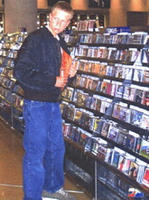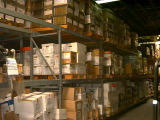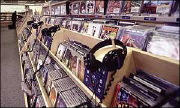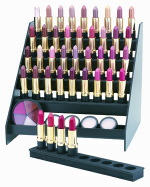Sept. 16, 2002 – The mission of the Auto-ID Center is to create a global system for tracking goods as they move from one country to another and one company to another. The potential benefits of such a system are unprecedented. Imagine Dell selling a computer and being able to know precisely which computer it was, when it was made and every component in it. The company would be able to let suppliers around the world know virtually instantly that one of their components had been sold, giving them real-time data on demand and enabling them to match the manufacturer’s needs more precisely, reducing inventories throughout the entire supply chain.
But the retailers and CPG manufacturers who are sponsoring the Auto-ID Center and participating in its field test say they are looking – at least initially – to deploy the technology where they can get a return on investment from improving their own internal operations. The ROI will come from three primary areas: reducing out of stocks (which increases sales), cutting labor costs, and slashing inventories.
We believe retailers will drive adoption because they have the most to gain from using RFID. Items are not on the shelves at grocery and general merchandise stores about 5 to 10 percent of the time. So-called out of stocks average upwards of 15 percent on fast-moving items. Studies show that retailers lose 3 to 4 percent of sales because items aren’t on the shelves when people want them. If Wal-Mart can recapture even 1 percent of lost sales using RFID, it would bring in an extra $2 billion a year.
Theft — both by employees and shoplifters — is another major issue for retailers. In 2001, retailers lost 1.80 percent of their total annual sales to shrink, up from 1.69 percent the prior year, according to the latest national Retail Security Survey. That translates into $33.2 billion in lost sales. That’s a very big deal in an industry with razor-thin margins. Woolworths says theft by customers and employees at its 788 U.K. stores last year reduced gross margins from 7 percent to 1.7 percent.
RFID not only has the potential to dramatically reduce shoplifting and supply chain theft, but it can also virtually eliminate administrative errors, which make up 17.5 percent of retail shrinkage, and vendor fraud, which accounts for 5.9 percent. (In a later installment of this Special Report, we’ll explain how retailers plan to use RFID to reduce inventory shrinkage.)
The potential benefits of RFID have long been known. The real question is, Can companies deploy a system that is affordable and provides a big enough return on investment to justify the risk? The answer depends heavily on the cost of the system – and on the way it is deployed.
We don’t agree with the conventional wisdom that says companies will use RFID first to track pallets, then cases and eventually individual products. If tracking pallets offered huge benefits, more companies would be doing it today using proprietary systems. Companies will deploy the technology in ways that deliver the most return on investment. For retailers, that might mean tracking pallets, cases and even individual units of certain products, before they track pallets of other products.
As we mentioned in Part 1 of this report, the Auto-ID Center is making the business case for its technology using a tag price of 40 cents this year, 20 cents in 2004 (when adoption will begin ramping up) and 5 cents as volumes reach the billions in 2006. Does it really pay to put an RFID tag that cost 20 cents on a case that may be valued at $30 or $40?
The answer, not surprisingly, is it depends on the product. Those who have done the math say that even at 20 cents per tag, tracking pallets cases of certain products can pay off handsomely. These include fast-moving items such as snacks, beverages and cigarettes; items subject to high levels of theft, like CDs, computer games, cosmetics, and pharmaceuticals; and products with a short shelf-life, such as meats and seafood.
We’ll get into the details in a later installment of this Special Report, but here’s a brief explanation of how tracking pallets and cases can begin to cut out of stocks. Retailers will start by eliminating errors at the distribution center. When a retailer breaks down pallets from manufacturers to create pallets of mixed products to send to its own stores in a region, the shipment has either the wrong quantities or the items roughly 30 percent of the time. The results of the Auto-ID Center’s field test reveal that setting up readers in the case-pick area of a distribution center can reduce error rates significantly, which helps ensure the product is on the shelf when its supposed to be.
Next, the retailer installs readers at the dock doors of its distribution center, the back doors of its stores and between the storeroom and the sales floor. Information from the readers between the storeroom and sales floor has to be tied to a point-of-sales database using a middleware application. By tracking how much product has moved from the storeroom to the sales floor and subtracting the amount of product sold, say, every two hours, the store managers could have a clear idea of what items are out of stock or about to be sold out.
Retailers can then go a step further by creating special areas in warehouses and storerooms with readers on the shelves. Instead of just tracking the movement of items, they’ll have visibility into what’s actually in stock. That would further reduce the chances of an item being out of stock.
The ultimate aim of retailers is to use RFID to create a totally automated replenishment system – where shelves signal the backroom when they are running low and the backroom signals the distribution center when stock is running low and so on back through the supply chain. The system we just described is a long way from that. But the money saved on labor and the sales increase from reducing out of stocks can be reinvested into tagging cases for other items, where the benefits are less clear cut. That way, companies can introduce system-wide RFID tracking of cases in stages, without a having to make a huge investment up front. And by keeping the system relatively manual at first, they can take the time needed to upgrade IT systems (IT issues will be covered in a later installment of this report).
PwC Consulting estimates, in an Auto-ID Center White Paper, that it would cost a “typical” retailer with 800 stores nearly $50 million to create a system for tracking pallets and cases. That’s serious money, even for a company the size of Wal-Mart. Even if it can be done one region at a time, no retailer will undertake such a project without a clear understanding of the potential return.
PwC Consulting estimates that its typical retailer would save $55 million a year in labor costs from tracking pallets and cases and get $43 million in additional sales from reduced out of stocks at its 800 stores. That’s a pretty good ROI. Of course, history is littered with technologies that promised huge savings that never materialized. Are these figures realistic?
There’s no way to know for sure. But Wal-Mart’s attitude indicates that the benefits are both significant and real. Wal-Mart is intensely secretive, but our sources tell us that since Target — Wal-Mart’s chief competitor in the United States — joined the center in June, Wal-Mart has stepped up its already aggressive RFID efforts. A vendor we spoke to recently said Wal-Mart had asked it to bid on a supply chain pilot project. The vendor isn’t a member of the Auto-ID Center and doesn’t offer technology compatible with the center’s, but clearly Wal-Mart wants to learn how to deploy a system and is acting on several fronts.
We believe that barring a protracted economic slump, Wal-Mart will move quickly to implement the Auto-ID Center’s system to track pallets and cases of key items. When it has the system running across all its stores, Wal-Mart – more likely its suppliers – will consume 4 billion tags a year. That’s enough to drive the price down to 10 cents, based on the Auto-ID Center’s projections. But Wal-Mart won’t be alone.
Out of stocks affect manufacturers, as well as retailers. The PwC Consulting white paper estimates that a “typical manufacturer” with four plants and 10 distribution centers would gain $19 million from the reduction in out of stocks from case-level tracking. Larry Kellam, director of business-to-business supply-chain innovation at Procter & Gamble, says P&G experiences out of stocks of up to 10 percent on fast-moving items. He believes tracking individual items could cut that in half, boosting revenue on those items by 5 percent. But even case-level tracking will have an impact.
And the potential savings from reducing inventory are also significant. P&G had $3.6 billion in inventory at the close of the last financial year. Kellam says that P&G can reduce that by half when an RFID system and all the process changes are in place. That would free up $1.8 billion in working capital. But more important, it would reduce recurring supply chain costs by 20 percent, or more than $400 million per year.
Several leading members of the Auto-ID Center told us they will begin serious pilots either late this year or early next year. No one would admit to having a roadmap drawn up. Right now, most say they aren’t looking beyond the initial stage of tracking pallets and cases to drive internal efficiencies. Clearly, if Wal-Mart and a few of its key suppliers start tagging cases, that will consume enough chips and readers to begin driving down prices. Going back to the metaphor we used in Part 1, it will get the snowball moving toward the mountain ledge.
Once systems are installed and tracking cases with a high degree of accuracy, we see manufacturers and retailers moving fairly quickly to begin pilots that will explore how best to collaborate. Back in the early 1990s, Wal-Mart and P&G pioneered vendor-managed inventory in the discount retail market, starting with diapers. That system evolved into Wal-Mart’s RetailLink system and became the heart of the retailer’s supply chain strategy. Wal-Mart will likely want to take that system to the next level by sharing near-real-time data on the movement of pallets and cases with key suppliers to perfect the RFID-powered supply chain.
Once manufacturers and retailers are sharing data on the movement of cases, they can begin to test the benefits of tagging individual products. Retailers will set up special displays with RFID readers in the shelves. The manufacturer will put tags on the individual bottles of perfume or CDs. The two sides can then begin to learn how to respond to near-real-time demand signals from the shelves.
Many people say item-level tracking is many years away. But even at 20 cents per tag, retailers say there is a business case for using RFID on high-value, high-theft items, such as CDs, DVDs, perfumes and other cosmetics. As one Auto-ID Center sponsor put it: “If you have a shrink of 10 percent on a $25 product, then in theory, you can afford to spend up to $2.50 to protect that product, if it will eliminate the shrink.”
Retailers working with the Auto-ID Center are already considering creating separate areas where CDs will be stored. The area will have one entrance/exit with an RFID reader and it will be jazzed up to hide the fact that it is really a security pen. The CDs will each have an RFID tag that can be turned off at the checkout counter. If someone tries to steal a CD, the RFID tag should be picked up as the shoplifter walks out of the secure area. If not, systems will be designed to catch the thief at the main checkout area or door. Outfitting such an area with RFID readers and related IT infrastructure will cost less than $10,000, according to those looking to do this. Given that CDs are one of the top items stolen from discount stores, it’s not hard to see a rapid ROI.
Of course, RFID pilots are nothing new. Many have been launched over the past five years. Few led to implementations. The pilots under consideration now are different because they will be undertaken by companies already involved in the Auto-ID Center’s field test, companies that already understand the benefits of the system. The pilots will be aimed at figuring out how to deploy the system to get the most benefit.
Proof that companies are serious about adopting the technology already exists. Unilever has asked RedPrairie to develop a next-generation warehouse management system that can handle data from RFID tags. RedPrairie is looking for a hardware partner that can deliver the tags and readers that will be needed for a complete solution. Noah Dixon of RedPrairie says that once a partner is lined up, his company could have a product out within six months.
RFID Journal has learned that both Wal-Mart and Metro AG have asked SAP to develop technology that would take advantage of data from RFID tags. SAP has been working with BiosGroup on an agent-based replenishment system that would automate much of the routine decision making needed to make sure items are never out of stock (see Agents Key to RFID Supply Chains).
Companies would not commit to these investments if they weren’t serious about RFID. Most companies are keeping details of their plans secret, but we believe that, barring a dramatic unforeseen event, the first deployments of pallet- and case-tracking systems will begin late next year, around the time the Auto-ID Center officially launches its system. Expect to see the first smart shelves tracking individual items in stores in late 2004. By that time, our giant snowball will be well on its way down the mountainside. Some companies will be ready to roll with it. Others will be crushed.





